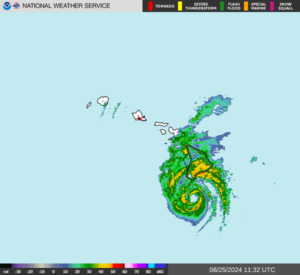Former Tropical Storm Hone strengthened to a hurricane south of Hawaii on Saturday night. At 5:00 a.m. EDT on Sunday the center of Hurricane Hone was located at latitude 18.2°N and longitude 155.3°W which put the center about 105 miles (165 km) south of Hilo, Hawaii. Hone was moving toward the west at 12 m.p.h. (19 km/h). The maximum sustained wind speed was 75 m.p.h. (120 km/h) and there were wind gusts to 90 m.p.h. (145 km/h). The minimum surface pressure was 991 mb.
A Tropical Storm Warning was in effect for Hawaii County (the Big Island).
Former Tropical Storm Hone strengthened to a hurricane during Saturday night as the center of Hone moved just south of South Point, Hawaii. A circular eye with a diameter of 30 miles formed at the center of Hone’s circulation. The eye was surrounded by a ring of thunderstorms and the strongest winds were occurring in that ring of storm, Bands of showers and thunderstorms were revolving around the center of Hone’s circulation. Storms near the center of Hone generated more upper level divergence that pumped mass away from the hurricane. The removal of more mass caused the surface pressure to decrease.
The size of the circulation around Hurricane Hone increased a little during Saturday night. Winds to hurricane force extended out 20 miles (30 km) in the northern side of Hone’s circulation. Winds to tropical storm force extended out 130 miles (210 km) from the center of Hurricane Hone.
Hurricane Hone will move through an environment favorable for intensification during the next 24 hours. Hone will move over water where the Sea Surface Temperatures are near 27°C. It will move under the southern side of an upper level ridge centered west of Hawaii. The upper level ridge will produce northeasterly winds that will blow toward the top of Hone’s circulation. Those winds will cause some vertical wind shear. The vertical wind shear will inhibit intensification, but the wind shear will not be enough to prevent intensification. Hurricane Hone is likely to intensify gradually during the next 24 hours.
Hurricane Hone will move around the southern side of a subtropical high pressure system over the Eastern North Pacific and Central Pacific. The high pressure system will steer Hone toward the west-northwest during the next 24 hours. On its anticipated track, the center Hurricane Hone will move away from of Hawaii County (the Big Island) on Sunday.
The core of Hurricane Hone where the strongest winds are will pass south of Hawaii County. Bands in the northern side of Hone’s circulation could bring strong winds to the Big Island. Electricity outages are likely. Those bands will also drop heavy rain on parts of Hawaii County. Heavy rain is likely to cause flash floods in some locations.
A Flood Watch is in effect for Hawaii County.
Elsewhere, Hurricane Gilma intensified to Category 4 on the Saffir-Simpson Scale over the Eastern North Pacific Ocean east of Hawaii. At 5:00 a.m. EDT on Sunday the center of Hurricane Gilma was located at latitude 18.0°N and longitude 132.5°W which put the center about 1480 miles (2380 km) east of Hilo, Hawaii. Gilma was moving toward the west-northwest at 9 m.p.h. (15 km/h). The maximum sustained wind speed was 130 m.p.h. (210 km/h) and there were wind gusts to 155 m.p.h. (250 km/h). The minimum surface pressure was 949 mb.

